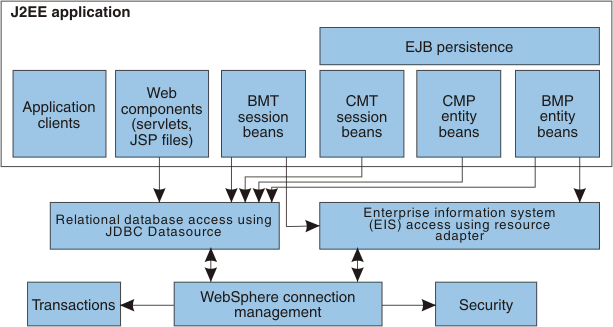
The J2EE Connector architecture defines a standard architecture that enables the integration of various enterprise information systems (EIS) with application servers and enterprise applications. It defines a standard resource adapter used by a Java application to connect to an EIS. This resource adapter can plug into the application server and, through the Common Client Interface (CCI), provide connectivity between the EIS, the application server, and the enterprise application.
The EJB 2.x architecture for container-managed persistence (CMP) provides a separation between the client view of a bean (as presented by its home and remote interfaces) and the entity bean instance (which provides the implementation of the client view). This separation enables you to change an entity bean independently from its clients. It also means that you can redeploy an entity bean across different persistence managers and different persistent data stores, without requiring the redefinition or re-compilation of the entity bean class.
The Bean Provider concentrates on the business logic of the object and defines the relationship through the abstract persistence schema; whereas the Persistence Manager is responsible for providing the implementation of the persistent fields and relationships, as well as all data access to the underlying persistent store. To achieve this portability, the EJB 2.x data access model is based on the J2EE Connector Architecture (JCA) specification. This specification is different from the EJB 1.x data access model that used the JDBC Connection Manager (CM) model from Version 4.0.
The EJB 2.x Persistence Resource Adapter model utilizes the JCA defined Resource Adapter to connect to various backend data stores without changing the persistence manager. JDBC applications that access relational databases using the JDBC or Embedded Structured Query language in Java (SQLJ) API indirectly use a WebSphere Application Server resource adapter specifically designed to work with JDBC data sources. The product also enables any JCA compliant connector to plug in, enabling the application to access an EIS system.
Users of data sources do not see any differences in the programming model from previous releases because of the underlying use of the JCA architecture. JDBC users still configure and use data sources according to the JDBC programming model. Note that some applications migrating from previous versions of the product can experience behavioral differences because of J2EE Version 1.3 requirements.
WebSphere Application Server provides support for the JDBC Connection Manager model from Version 4.0, enabling J2EE 1.2 applications to run unaltered. However, the EJB 2.x module within a J2EE 1.3 (or later version) application cannot use the 4.0 JDBC Connection Manager.
Consult the following concept, reference, and task files for more overview information.
Related concepts
Connection management architecture
Resource adapter
Connection factory
JDBC providers
Data sources
Related tasks
Task overview: Accessing data from applications
Related reference
Data access bean types